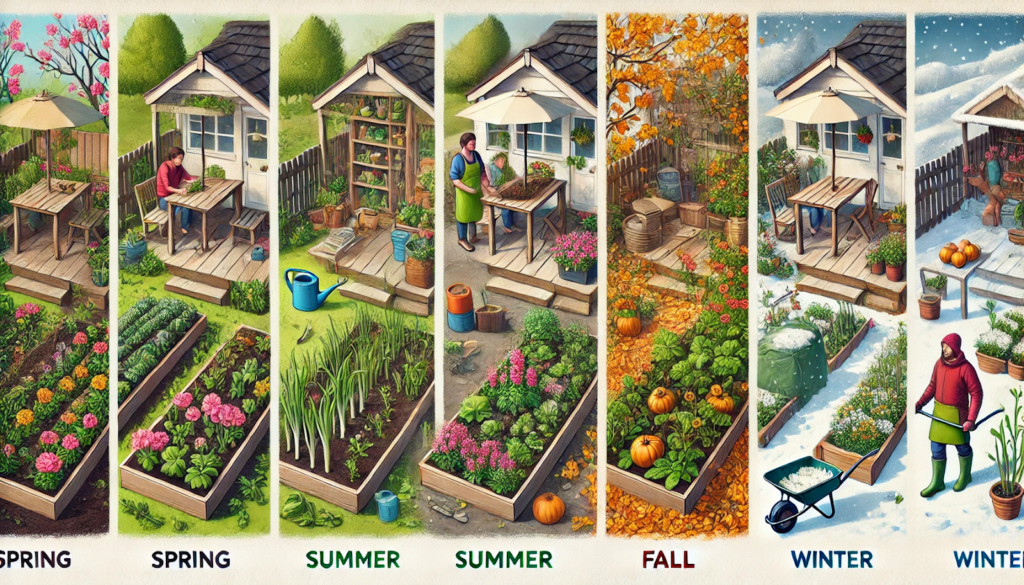Gardening is a year-round journey. Each season brings its own challenges, tasks, and opportunities to improve your garden’s health and productivity. By organizing your gardening activities around the seasons, you’ll not only save time and effort, but also help your plants thrive throughout the year.
In this comprehensive seasonal guide, we’ll walk through the most effective gardening tasks to focus on during each part of the year—spring, summer, fall, and winter.
Spring Gardening Tasks (March to May)
Spring marks the beginning of the growing season. It’s a time of renewal, preparation, and planting. Proper spring care sets the foundation for the rest of the year.
Key Tasks:
- Clean up beds: Remove dead leaves, weeds, and old mulch
- Test and amend soil: Add compost and organic matter
- Start seeds indoors: Especially tomatoes, peppers, and herbs
- Transplant seedlings: Once the danger of frost has passed
- Plant cool-season crops: Lettuce, spinach, carrots, radishes, peas
- Divide perennials: Such as hostas and daylilies
- Apply mulch: To suppress weeds and retain moisture
- Sharpen tools and check irrigation systems
Tip: Keep row covers or frost cloth handy for unpredictable cold snaps.
Summer Gardening Tasks (June to August)
Summer is the busiest season in the garden, where most plants are actively growing, flowering, or producing fruit. It’s also the time when heat and pests can stress your plants.
Key Tasks:
- Water deeply and early in the day: Encourage strong root systems
- Fertilize crops: Especially fruiting vegetables and flowers
- Harvest frequently: Regular harvesting encourages more growth
- Deadhead spent blooms: To promote continuous flowering
- Monitor for pests and diseases: Use organic treatments as needed
- Stake or support tall plants: Such as tomatoes or sunflowers
- Weed regularly: Don’t let weeds steal moisture and nutrients
- Succession plant: Sow quick-growing crops like greens or radishes
Tip: Use shade cloth to protect sensitive crops during heatwaves.
Fall Gardening Tasks (September to November)
Fall is a season of transition. It’s the ideal time to wind down the garden, plant for spring, and improve your soil for the next cycle.
Key Tasks:
- Harvest remaining crops: Dry, freeze, or can excess produce
- Plant garlic and spring bulbs: Tulips, daffodils, onions
- Sow cold-hardy crops: Kale, spinach, arugula, in early fall
- Add compost to beds: Restore nutrients before winter
- Rake leaves and use them as mulch or compost material
- Remove spent plants and clean garden tools
- Cover bare soil: With straw, cardboard, or cover crops
Tip: Leave some seed heads for birds and shelter for pollinators.
Winter Gardening Tasks (December to February)
Even when the garden appears dormant, there are valuable tasks to be done. Winter is the perfect time to plan, organize, and prepare for spring.
Key Tasks:
- Plan your garden layout: Choose crops, rotate planting zones
- Order seeds and supplies early: Before spring demand peaks
- Start long-season seeds indoors: Like onions, celery, and leeks
- Prune deciduous trees and shrubs: While they are dormant
- Clean and sharpen tools: Extend their life and performance
- Force bulbs indoors: Such as amaryllis or paperwhites
- Continue composting: Add kitchen scraps and turn the pile
- Check stored seeds and produce: Remove anything spoiled
Tip: Take gardening classes or read new gardening books during the off-season.
Month-by-Month Gardening Overview
| Month | Focus Area |
| March | Soil prep, start seeds, plant hardy greens |
| April | Transplant seedlings, mulch beds, plant bulbs |
| May | Sow warm-season crops, install supports |
| June | Fertilize, harvest early crops, pest monitoring |
| July | Water deeply, succession plant, deadhead flowers |
| August | Begin fall garden prep, start seed saving |
| September | Plant garlic, compost cleanup, prune if needed |
| October | Mulch, remove annuals, protect perennials |
| November | Store tools, enrich soil, plant final bulbs |
| December | Plan garden layout, organize tools and supplies |
| January | Order seeds, prune trees, clean containers |
| February | Start early seeds indoors, force bulbs for color |
Tips for Year-Round Garden Success
- Keep a garden journal: Track what works, planting dates, and weather notes
- Use compost consistently: Improves soil health and structure
- Practice crop rotation: Helps prevent soil depletion and disease
- Group plants by care needs: Saves water and simplifies maintenance
- Stay informed: Monitor frost dates and regional planting calendars
Conclusion: Let the Seasons Guide Your Garden
Gardening isn’t just a spring or summer activity—it’s a continuous cycle that rewards thoughtful planning and seasonal care. By aligning your efforts with each season’s natural rhythm, you’ll build a more resilient, productive, and beautiful garden year after year.






